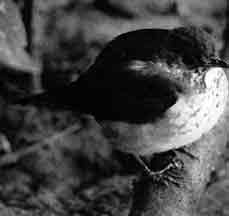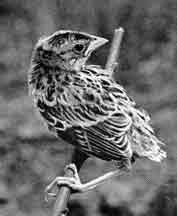An Avian Creche, Page 2
By H.R. IVOR
Bonnie was a great help, and on the second day as foster parent I found another aide. The call notes of the three baby wood thrushes attracted the attention of the old wood thrush still in the aviary. Her head cocked on one side, she listened. She made a little run toward one of the babies, seeming partly puzzled, partly fearful. She would stop and run toward the food dish, then approach the youngsters again. With each approach the desire to feed them grew. Then she would dash back to the food dish for repeated dabs, until her bill was full; then to the little thrushes. She stood over them uncertainly, for they would not recognize her as a parent and would not open their bills. In two days twelve-day-old baby wood thrushes had forgotten their kind! Yet memory would return and Vee, as we named her, knew her kind, refusing to feed the baby veery thrushes, who, curiously enough, opened their bills when she was near.

A WILSON'S THRUSH, OR VERRY, AT THE IVOR AVIARY
Vee, however, had made up her mind to feed those thrush babies. She would follow them around, beak crammed with food. She would gently peck a youngster and utter a low call note. Failing to interest one stubborn little bird, Vee would try another and then the third, losing some of the food en route and going back to the food dish for more. Once while she was coaxing a nestling I offered it food. The orange yellow mouth popped open and before I could fill it Vee popped her billful in. That seemed to break the ice and her persistence was rewarded.
However, the little thrushes usually seemed reluctant to take the food from her. Impatiently she would peck them on the head, unintentionally hurting them. So they were placed in the enclosed porch off the aviary, and, since most of the other nestlings had taken to roosting in places where I could not reach them with the food stick, all the others except the blue jays were transferred there, also. Shrubbery there provided exercise, and Bonnie Bluebird went along to help with the feeding. Moving around or through this porch became something requiring care, for one never knew when a baby bird would dart under one's feet.

BOBO, ONE OF THE YOUNG BOBLINKS
Meanwhile, Vee was still in the aviary and kept flying to the wire with food in her bill to feed the little thrushes. The second day I let her in and she went immediately to work. For some reason we shall never know she no longer concentrated on the nestlings of her kind. She began to feed all fifteen, showing no favoritism. And now, too, the thrushes accepted her offerings without hesitation.
Vee was untiring. Running to a feed jar she would fill her bill, a dab at a time. Then off to thrush or bobolink or cardinal. Part of a beakful would pop into one waiting mouth, part into another, until the beak was empty. Then she ran back for more. She never seemed to stop to eat, herself. She never inserted her beak gently into the mouths of the youngsters. It went in with a sudden, incisive motion. This worked well with thrushes or cardinals, with their great, gaping mouths. But bobolinks and orioles had been designed for different treatment. The mother oriole on mess duty inserts her long, needle-like bill into the throat of her young, and the bobolink is a gentle feeder. Such niceties were no concern to Vee. She did not know these tricks and probably would not have cared but was intent only on seeing that the whole group was well fed.
 Printer-friendly version
Printer-friendly version
